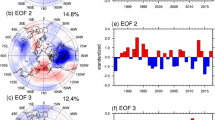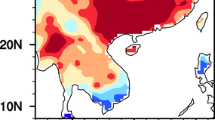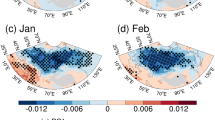Abstract
The first two empirical orthogonal function (EOF) modes of the surface air temperature (SAT) interannual variability in the South American (SA) continent have been revealed in several previous studies. This presentation focuses on winter season and furtherly investigates the detailed advection and cloud-radiation processes and teleconnections from tropical sea surface temperature anomalies (SSTA) combining statistical analysis with Rossby wave dynamics and modelling experiments. The EOF1, featured with the anomalous center in the central part, is related to the tropical eastern Pacific SSTA, which may impact on the SA SAT variability through the Walker circulation and a regional Hadley cell. The anomalous center is largely attributed to low-level advection transported by the Hadley cell. The EOF2, as a fluctuation between anomalies in the southeast Brazil and the southern tip, is related to the SSTA surrounding the Maritime Continent, which may generate a barotropic wave train propagating to the SA continent. This wave train can strengthen high latitude westerly flow transporting warm advection to the southern tip, and generate southeast anomalous flow transporting cold advection to the southeast Brazil. Meanwhile, the cloud-radiation processes are also involved to enhance the advection-induced SAT anomalies in both areas.












Similar content being viewed by others
References
Aceituno P (1988) On the functioning of the Southern Oscillation in the South American sector. Part I: surface climate. Mon Weather Rev 116:505–524
Alexander MA, Bladé I, Newman M et al (2002) The atmospheric bridge: The influence of ENSO teleconnections on air-sea interaction over the global oceans. J Clim 15:2205–2231
Barreiro M, Tippmann A (2008) Atlantic modulation of El Niño influence on summertime rainfall over Southeastern South America. Geophys Res Lett 35:L16704. https://doi.org/10.1029/2008GL035019
Barros VR, Grimm AM, Doyle ME (2002) Relationship between temperature and circulation in Southeastern South America and its influence from El Niño and La Niña events. J Meteorol Soc Japan 80:21–32. https://doi.org/10.2151/jmsj.80.21
Berbery EH, Nogués-Paegle J (1993) Intraseasonal interactions between the tropics and extratropics in the Southern Hemisphere. J Atmos Sci 50:1950–1965
Berman AL, Silvestri G, Compagnucci R (2012) Eastern Patagonia seasonal precipitation: influence of southern hemisphere circulation and links with subtropical South American precipitation. J Clim 25:6781–6795. https://doi.org/10.1175/JCLI-D-11-00514.1
Berman AL, Silvestri G, Compagnucci R (2013) On the variability of seasonal temperature in southern South America. Clim Dyn 40:1863–1878. https://doi.org/10.1007/s00382-012-1596-5
Bombardi RJ, Carvalho LMV, Jones C, Reboita MS (2014) Precipitation over eastern South America and the South Atlantic Sea surface temperature during neutral ENSO periods. Clim Dyn 42:1553–1568. https://doi.org/10.1007/s00382-013-1832-7
Bracco A, Kucharski F, Kallummal R, Molteni F (2004) Internal variability, external forcing and climate trends in multi-decadal AGCM ensembles. Clim Dyn 23:659–678
Carleton AM (2003) Atmospheric teleconnections involving the Southern Ocean. J Geophys Res https://doi.org/10.1029/2000jc000379
Cerne SB, Vera CS (2011) Influence of the intraseasonal variability on heat waves in subtropical South America. Clim Dyn 36:2265–2277. https://doi.org/10.1007/s00382-010-0812-4
Chen M, Xie P, Janowiak JE, Arkin PA (2002) Global Land Precipitation: A 50-yr Monthly Analysis Based on Gauge Observations. J of Hydrometeorology 3:249–266
Chen SF, Wu RG, Liu Y (2016) Dominant modes of interannual variability in Eurasian surface air temperature during boreal spring. J Clim 29:1109–1125. https://doi.org/10.1175/JCLI-D-15-0524.1
Collins JM, Chaves RR, da Silva Marques V (2009) Temperature variability over South America. J Clim 22:5854–5869. https://doi.org/10.1175/2009JCLI2551.1
Coronato F, Bisigato A (1998) A temperature pattern classification in Patagonia. Int J Climatol 18:765–773
Díaz A, Aceituno P (2003) Atmospheric circulation anomalies during episodes of enhanced and reduced convective cloudiness over Uruguay. J Clim 16:3171–3185
Dogar MM, Kucharski F, Azharuddin S (2017) Study of the global and regional climatic impacts of ENSO magnitude using SPEEDY AGCM. J Earth Syst Sci. https://doi.org/10.1007/s12040-017-0804-4
Garreaud RD (1999) Cold air incursions over subtropical and tropical South America: A numerical case study. Mon Weather Rev 127:2823–2853
Garreaud RD (2000) Cold air incursions over subtropical South America: mean structure and dynamics. Mon Weather Rev 128:2544–2559
Garreaud RD, Vuille M, Compagnucci R, Marengo J (2009) Present-day South American climate. Palaeogeogr Palaeoclimatol Palaeoecol 281:180–195. https://doi.org/10.1016/j.palaeo.2007.10.032
Garreaud RD, Lopez P, Minvielle M, Rojas M (2013) Large-scale control on the Patagonian Climate. J Clim 26:215–230. https://doi.org/10.1175/JCLID1200001.1
Grimm AM (2003) The El Niño impact on the summer monsoon in Brazil: regional processes versus remote influences. J Clim 16:263–280
Grimm AM (2004) How do La Niña events disturb the summer monsoon system in Brazil? Clim Dyn 22:123–138
Grimm AM (2011) Interannual climate variability in South America: Impacts on seasonal precipitation, extreme events, and possible effects of climate change. Stoch Environ Res Risk Assess 25:537–554. https://doi.org/10.1007/s00477-010-0420-1
Grimm AM, Natori AA (2006) Climate change and interannual variability of precipitation in South America. Geophys Res Lett 33:1–5. https://doi.org/10.1029/2006GL026821
Grimm AM, Zilli MT (2009) Interannual variability and seasonal evolution of summer monsoon rainfall in South America. J Clim 22:2257–2275. https://doi.org/10.1175/2008JCLI2345.1
Halpert MS, Ropelewski CF (1992) Surface temperature patterns associated with the Southern Oscillation. J Clim 5:577–593
Held IM, Suarez MJ (1994) A proposal for the intercomparison of dynamical cores of atmospheric general circulation models. Bull Am Meteorol Soc 75:1825–1830
Herceg Bulic I, Brankovic C (2007) ENSO forcing of the Northern Hemisphere climate in a large ensemble of model simulations based on a very long SST record. Clim Dyn 28:231–254
Hoskins BJ, Karoly DJ (1981) The steady linear response of a spherical atmosphere to thermal and orographic forcing. J Atmos Sci 38:1179–1196
Jacques-Coper M, Bronnimann S (2014) Summer temperature in the eastern part of southern South America: its variability in the twentieth century and a teleconnection with Oceania. Clim Dyn 43:2111–2130. https://doi.org/10.1007/s00382-013-2038-8
Kalnay E et al (1996) The NCEP/NCAR 40-year reanalysis project. Bull Amer Meteor Soc 77:437–471
Karoly DJ (1983) Rossby wave propagation in a barotropic atmosphere. Dyn Atmos Ocean 7:111–125
Karoly DJ (1989) Southern Hemisphere circulation features associated with El Niño–Southern Oscillation events. J Clim 2:1239–1252
Kayano MT, Andreoli RV, de Souza RAF, Garcia SR (2017) Spatiotemporal variability modes of surface air temperature in South America during the 1951–2010 period: ENSO and non-ENSO components. Int J Climatol. https://doi.org/10.1002/joc.4972
Kiladis G, Diaz HF (1989) Global climatic anomalies associated with extremes in the Southern Oscillation. J Clim 2:1069–1090
Kiladis GN, Weickmann KM (1997) Horizontal structure and seasonality of large-scale circulations associated with submonthly tropical convection. Mon Weather Rev 125:1997–2013
Kucharski F, Molteni F, Bracco A (2006) Decadal interactions between the western tropical Pacific and the North Atlantic Oscillation. Clim Dyn 26:79–91
Kucharski F, Bracco A, Yoo JH, Molteni F (2007) Low-frequency variability of the Indian monsoon-ENSO relationship and the Tropical Atlantic: the “Weakening” of the 1980s and 1990s. J Clim 20:4255–4266
Kucharski F, Bracco A, Yoo JH, Molteni F (2009) A Gill-Matsuno-type mechanism explains the Tropical Atlantic influence on African and Indian monsoon rainfall. Q J R Meteorol Soc 135:569–579
Kucharski F, Kang IS, Farneti R, Feudale L (2011) Tropical Pacific response to 20th century Atlantic warming. Geophys Res Lett 38:L03702. https://doi.org/10.1029/2010GL046248
Kucharski F, Molteni F, King MP, Farneti R, Kang I-S, Feudale L (2013) On the need of intermediate complexity general circulation models: a ‘SPEEDY’ example. Bull Amer Meteor Soc 94:25–30. https://doi.org/10.1175/BAMS-D-11-00238.1
Lau N-C, Nath MJ (1996) The role of the “atmospheric bridge” in linking tropical Pacific ENSO events to extratropical SST anomalies. J Clim 9:2036–2057
Li YJ, Li JP (2012) Propagation of planetary waves in the horizontal non-uniform basic flow (in Chinese). Chin J Geophys 55:361–371
Li L, Nathan TR (1997) Effects of low-frequency tropical forcing on intraseasonal tropical-extratropical interactions. J Atmos Sci 54:332–346
Li YJ, Li JP, Jin FF, Zhao S (2015) Interhemispheric propagation of stationary Rossby waves in a horizontally nonuniform background flow. J Atmos Sci 72:3233–3256. https://doi.org/10.1175/JAS-D-14-0239.1
Liu ZY, Alexander M (2007) Atmospheric bride, oceanic tunnel, and global climate teleconnections. Rev Geophys 45:1–34. https://doi.org/10.1029/2005RG000172.1.INTRODUCTION
Losada T, Rodríguez-Fonseca B, Kucharski F (2012) Tropical influence on the summer Mediterranean climate. Atmos Sci Lett 13:36–42
Marengo J, Rogers J (2001) Cold front and Polar Air Outbreaks in the Americas during: Modern climate assessments and impacts, and some Past climate evidences. In: Markgraf V (ed) Present and past inter-hemispheric climate linkages in the Americas and their societal effects. Academic Press, London, pp 31–51
Marengo J, Cornejo A, Satymurty P, Nobre C, Sea W (1997) Cold surges in tropical and extratropical South America: The strong event in June 1994. Mon Weather Rev 125:2759–2786
Mo KC, Ghil M (1987) Statistics and dynamics of persistent anomalies. J Atmos Sci 44:877–902
Mo KC, Higgins RW (1998) The Pacific-South American modes and tropical convection during the Southern Hemisphere winter. Mon Weather Rev 126:1581–1596
Mo KC, Paegle JN (2001) The Pacific–South American modes and their downstream effects. Int J Climatol. 21:1211–1229. https://doi.org/10.1002/joc.685
Mohino E, Losada T (2015) Impacts of the Atlantic Equatorial Mode in a warmer climate. Clim Dyn 45:2255–2271. https://doi.org/10.1007/s00382-015-2471-y
Molteni F (2003) Atmospheric simulations using a GCM with simplified physical parameterizations. I. Model climatology and variability in multi-decadal experiments. Clim Dyn 20:175–191
Moura AD, Shukla J (1981) On the dynamics of droughts in Northeast Brazil: observations, theory and numerical experiments with a general circulation model. J Atmos Sci 38:2653–2675
Müller GV, Berri GJ (2007) Atmospheric Circulation associated with persistent generalized frosts in central southern South America. Mon Weather Rev 135:1268–1289. https://doi.org/10.1175/MWR3344.1
Nnamchi HC, Li J, Kang IS, Kucharski F (2013) Simulated impacts of the South Atlantic Ocean Dipole on summer precipitation at the Guinea Coast. Clim Dyn 41:677–694. https://doi.org/10.1007/s00382-012-1629-0
North GR et al (1982) Sampling errors in the estimation of empirical orthogonal functions. Mon Weather Rev 110:699–706
Pittock AB (1980) Patterns of climatic variation in Argentina and Chile - II. Termperature, 1931–60. Mon Weather Rev 108:1362–1369
Rodriguez-Fonseca B, Polo I, Garcia-Serrano J, Losada T, Mohino E, Mechoso CR, Kucharski F (2009) Are Atlantic Niños enhancing Pacific ENSO events in recent decades? Geophys. Res Lett 36:L20705. https://doi.org/10.1029/2009GL040048
Rusticucci M (2012) Observed and simulated variability of extreme temperature events over South America. Atmos Res 106:1–17. https://doi.org/10.1016/j.atmosres.2011.11.001
Rusticucci M, Vargas W (1995) Synoptic situations related to spells of extreme temperatures over Argentina. Meteor Appl 2:291–300
Sardeshmukh PD, Hoskins BJ (1988) The generation of global rotational flow by steady idealized tropical divergence. J Atmos Sci 45:1228–1251
Schultz D, Bracken WE, Bosart L (1998) Planetary- and synoptic-scale signature associated with Central American cold surges. Mon Weather Rev 126:5–27
Shimizu MH, Ambrizzi T (2016) MJO influence on ENSO effects in precipitation and temperature over South America. Theor Appl Climatol 124:291–301. https://doi.org/10.1007/s00704-015-1421-2
Skansi M, Brunet M, Sigró J et al (2013) Warming and wetting signals emerging from analysis of changes in climate extreme indices over South America. Glob Planet Change 100:295–307. https://doi.org/10.1016/j.gloplacha.2012.11.004
Storch HV, Zwiers FW (2003) Statistical analysis in climate research. Cambridge University Press
Sun C, Li J, Jin FF (2015) A delayed oscillator model for the quasi-periodic multidecadal variability of the NAO. Clim Dyn 45:2083–2099. https://doi.org/10.1007/s00382-014-2459-z
Torres RR, Marengo JA (2014) Climate change hotspots over South America: From CMIP3 to CMIP5 multi-model datasets. Theor Appl Climatol 117:579–587. https://doi.org/10.1007/s00704-013-1030-x
Trenberth KE, Branstator GW, Karoly D et al (1998) Progress during TOGA in understanding and modeling global teleconnections associated with tropical sea surface temperatures. J Geophys Res 103:14291–14324
Vera CS, Vigliarolo PK (2000) A diagnostic study of cold-air outbreaks over South America. Mon Weather Rev 128:3–24
Vincent LA, Peterson TC, Barros VR et al (2005) Observed trends in indices of daily temperature extremes in South America 1960–2000. J Clim 18:5011–5023. https://doi.org/10.1175/JCLI3589.1
Willmott CJ, Matsuura K (2001) Terrestrial air temperature and precipitation: monthly and annual time series (1950–1999), http://climate.geog.udel.edu/~climate/html_pages/README.ghcn_ts2.html
World Meteorological Organization (2008) WMO statement on the status of the global climate in 2007. Switzerland
World Meteorological Organization (2010) WMO statement on the status of the global climate in 2009. Switzerland
World Meteorological Organization (2014) WMO statement on the status of the global climate in 2013. Switzerland
Yadav RK, Yoo JH, Kucharski F, Abid MA (2010) Why is ENSO influencing Northwest India winter precipitation in recent decades? J Clim 23:1979–1993
Zamboni L, Kucharski F, Mechoso CR (2012) Seasonal variations of the links between the interannual variability of South America and the South Pacific. Clim Dyn 38:2115–2129. https://doi.org/10.1007/s00382-011-1116-z
Zhao S, Li JP, Li YJ (2015) Dynamics of an interhemispheric teleconnection across the critical latitude through a southerly duct during boreal winter. J Clim 28:7437–7456. https://doi.org/10.1175/JCLI-D-14-00425.1
Zhou J, Lau KM (2001) Principal modes of interannual and decadal variability of summer rainfall over South America. Int J Climatol 21:1623–1644. https://doi.org/10.1002/joc.700
Acknowledgements
The authors thank two anonymous reviewers for providing useful comments. This work was jointly supported by the National Natural Science Foundation of China (NSFC) (projects 41575060 and 91437216), the SOA International Cooperation Program on Global Change and Air-Sea Interactions (GASI-IPOVAI-03). NCEP/NCAR reanalysis data, PREC precipitation data, and ERSST V4 data are provided by the NOAA/OAR/ESRL PSD, Boulder, Colorado, USA, from their Web site at http://www.esrl.noaa.gov/psd/.
Author information
Authors and Affiliations
Corresponding author
Rights and permissions
About this article
Cite this article
Li, Y., Li, J., Kucharski, F. et al. Two leading modes of the interannual variability in South American surface air temperature during austral winter. Clim Dyn 51, 2141–2156 (2018). https://doi.org/10.1007/s00382-017-4004-3
Received:
Accepted:
Published:
Issue Date:
DOI: https://doi.org/10.1007/s00382-017-4004-3




